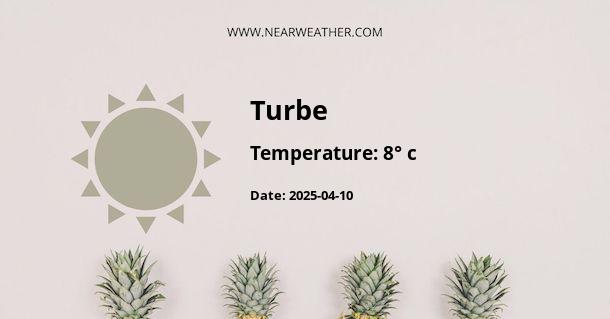Exploring the Climate and Weather of Turbe, Bosnia and Herzegovina
In the picturesque landscapes of Bosnia and Herzegovina, a small but significant location captures the essence of the country's diverse climatic personality. Turbe, situated within the central region of Bosnia and Herzegovina, is not only breathtaking but also an exemplar of a transitional climate zone. Understanding the weather patterns and climate of Turbe involves delving into various meteorological elements, statistics, and seasonal characteristics unique to this area.
Geographical Context of Turbe
Turbe is nestled amidst varied topography which includes mountains, valleys, and rivers, contributing to its distinct climate. The intricate terrain acts as a barrier and catalyst for specific weather phenomena, which is why the climate is mostly described as continental with Mediterranean influences.
Temperature Overview
According to the meteorological data from the region, average temperatures in Turbe can range from chilly winters to warm summers, indicating a notable seasonal variation influenced by its inland location.
| Season | Temperature Range (°C) |
|---|---|
| Winter (Dec-Feb) | -3 to 3 |
| Spring (Mar-May) | 5 to 15 |
| Summer (Jun-Aug) | 13 to 25 |
| Autumn (Sep-Nov) | 6 to 14 |
Precipitation Patterns
Precipitation in Turbe is fairly distributed throughout the year, with a slight peak during the autumn months. Rainfall is usually moderate, but the region can experience heavier spells influenced by the transitional continental-Mediterranean climate.
It is important to highlight that this region can be susceptible to sudden and intense weather events, which are characteristic of transitional climate zones.
- Winter: Snowfall is common, coupled with rain leading to varied precipitation forms.
- Spring: Gradual increase in rainfall, with a mix of rain and late-season snow.
- Summer: Less precipitation, occasional thunderstorms can occur driving sudden downpours.
- Autumn: Rainfall increases, contributing to the wettest season in Turbe.
Monthly Climate Breakdown
A closer month-to-month examination provides a detailed picture of Turbe's weather and climate. Typically, the coldest month is January, while July often brings the highest temperatures. Here's a succinct overview:
- January: Coldest month, high probability of snow, low sunlight hours.
- February: Still cold, with gradual increase in daylight, end of the snow season.
- March: Transition into spring, temperatures begin to rise, melting snow.
- April: Noticeable warmth, with increased likelihood of rain showers.
- May: Warmer temperatures, plenty of greenery, moderate rainfall.
- June: Beginning of summer, longer days, relatively lower precipitation.
- July: Peak of summer, highest temperature averages, occasional heat waves.
- August: Similar to July, but with a slight decrease in temperature.
- September: Early signs of autumn, mild temperatures, increase in rainfall.
- October: Distinct autumn weather, cooler temperatures, frequent rain.
- November: Noticeable drop in temperatures, preparation for winter season.
- December: Onset of winter, shortest days of the year, temperatures plummet.
Extreme Weather and Climate Events
Like most regions with complex climatic conditions, Turbe is not immune to extreme weather. The interplay between continental and Mediterranean climates can lead to significant weather anomalies such as:
- Severe thunderstorms potentially leading to flash floods.
- Heatwaves during the summer months.
- Heavy snowfall which may lead to disruption during the winter.
- Rapid temperature changes that challenge the adaptability of the local ecosystem.
Wind Patterns
Wind patterns in Turbe exhibit behavior that is characteristic of inland mountainous regions. Downslope winds can become quite prominent, and valley channels can funnel and intensify specific wind patterns.
Local topography plays an integral role in both the speed and direction of prevailing winds, which can have a significant influence on the region's day-to-day weather.
Impact of Climate on Turbe's Lifestyle and Culture
The climate in Turbe is inextricably linked to the local way of life and culture. Agricultural practices, traditional festivities, and even culinary habits are often tied to the changing seasons and associated weather conditions.
- Agriculture: Farming is adjusted to the rhythm of the seasons, with crop selection and harvesting times influenced by weather patterns.
- Festivities: Many local festivities and traditions are timed to coincide with specific weather periods, such as the end of the harvest season or the beginning of spring.
- Cuisine: Seasonal climate changes drive the availability of local produce, which is reflected in seasonal food specialties.
Future Climate Considerations
As global climate change continues to influence weather patterns around the world, Turbe is likely to experience shifts in its historically observed climate norms. Experts predict variations in precipitation, temperature extremes, and the potential for more frequent extreme weather events.
It is imperative for local authorities and the community to consider these future climate projections in urban planning, infrastructure development, and agriculture to build resilience against these changes.
Conclusion
Turbe's climate and weather year-round are reflective of its intricate geographical location and topography. Navigating through the temperatures, precipitation, and extreme weather events provides insight not just into the meteorological aspects but also into the very fabric of local life. Timely and precise weather forecasts, climatic research, and adaptive practices are central to understanding and living harmoniously with the climate in Turbe, Bosnia and Herzegovina.
A - Turbe's Latitude is 44.243610 & Longitude is 17.571390.
A - Weather in Turbe is 8° today.
A - Climate Conditions in Turbe shows light rain today.
A - Humidity in Turbe is 81% today.
A - Wind speed in Turbe is 13 km/h, flowing at 340° wind direction. today.
